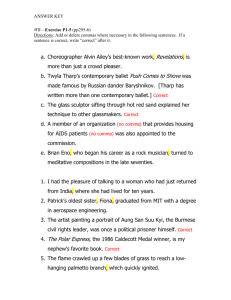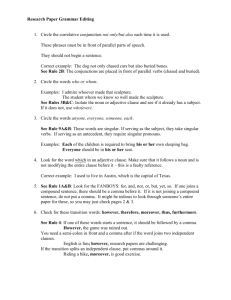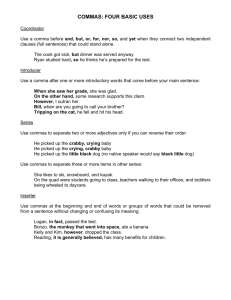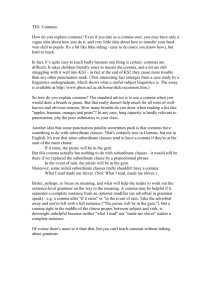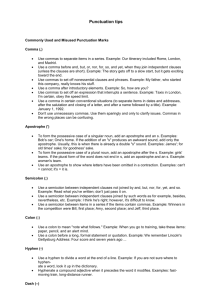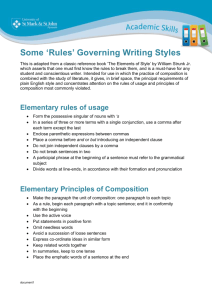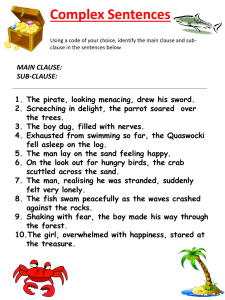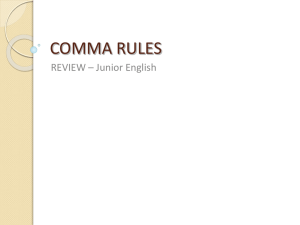Unit 1: Sentence Structure and Punctuation
advertisement
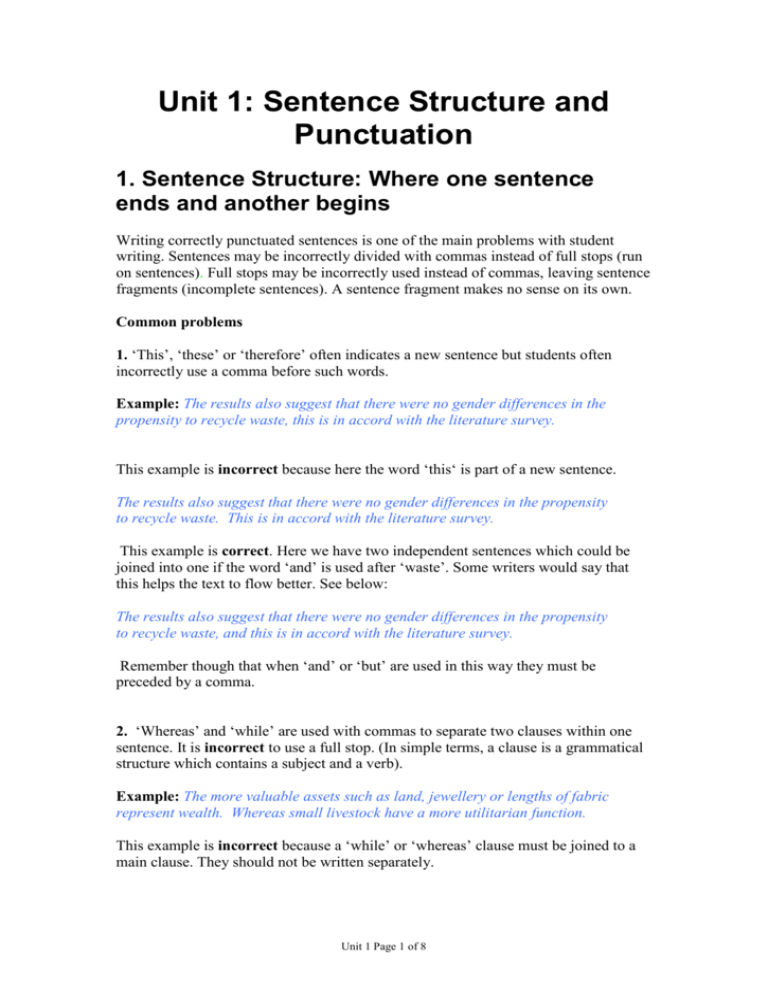
Unit 1: Sentence Structure and Punctuation 1. Sentence Structure: Where one sentence ends and another begins Writing correctly punctuated sentences is one of the main problems with student writing. Sentences may be incorrectly divided with commas instead of full stops (run on sentences). Full stops may be incorrectly used instead of commas, leaving sentence fragments (incomplete sentences). A sentence fragment makes no sense on its own. Common problems 1. ‘This’, ‘these’ or ‘therefore’ often indicates a new sentence but students often incorrectly use a comma before such words. Example: The results also suggest that there were no gender differences in the propensity to recycle waste, this is in accord with the literature survey. This example is incorrect because here the word ‘this‘ is part of a new sentence. The results also suggest that there were no gender differences in the propensity to recycle waste. This is in accord with the literature survey. This example is correct. Here we have two independent sentences which could be joined into one if the word ‘and’ is used after ‘waste’. Some writers would say that this helps the text to flow better. See below: The results also suggest that there were no gender differences in the propensity to recycle waste, and this is in accord with the literature survey. Remember though that when ‘and’ or ‘but’ are used in this way they must be preceded by a comma. 2. ‘Whereas’ and ‘while’ are used with commas to separate two clauses within one sentence. It is incorrect to use a full stop. (In simple terms, a clause is a grammatical structure which contains a subject and a verb). Example: The more valuable assets such as land, jewellery or lengths of fabric represent wealth. Whereas small livestock have a more utilitarian function. This example is incorrect because a ‘while’ or ‘whereas’ clause must be joined to a main clause. They should not be written separately. Unit 1 Page 1 of 8 Example: The more valuable assets such as land, jewellery or lengths of fabric represent wealth, whereas small livestock have a more utilitarian function. This example is correct. Note that a ‘while or whereas’ clause can also be used at the beginning of a sentence. Other words that can be used in this way are ‘if’, ‘when’, ‘although’ and ‘because’. Example: While the results are indicative of a successful programme, the authors raise a concern that the overcrowding of classrooms could lower school quality. 3. ‘However’, used to indicate contrast, should be used in a separate (new) sentence. ‘However’ can also be preceded by a semi-colon (;). Example: Huberman (1996) suggests that efficiency wages may have appeared as early as the 1830s in cotton textile factories, however such compensation systems are not likely to have been important in an occupation such as agricultural labour. This example is incorrect because ‘however’ is normally used to begin a separate (new) sentence. Huberman (1996) suggests that efficiency wages may have appeared as early as the 1830s in cotton textile factories. However, such compensation systems are not likely to have been important in an occupation such as agricultural labour. Huberman (1996) suggests that efficiency wages may have appeared as early as the 1830s in cotton textile factories; however, such compensation systems are not likely to have been important in an occupation such as agricultural labour. Both of these are correct. The second example is less common but some writers say that it helps the writing to flow better. 4. ‘However’ does not have to be the first word of the new sentence. It can come after another word or phrase. In this case, it is separated by commas. Example: Huberman (1996) suggests that efficiency wages may have appeared as early as the 1830s in cotton textile factories. Such compensation systems, however, are not likely to have been important in an occupation such as agricultural labour. Some writers say that placing ‘however’ in the non-initial position like this also enhances a sense of ‘flow’, making the writing less abrupt. Like ‘however’, the word ‘but’ can be used to indicate contrast. Unlike ‘however’, ‘but’ is generally used to join two ideas within the same single sentence and is preceded by a comma. Unit 1 Page 2 of 8 Example: Huberman suggests that efficiency wages may have appeared as early as the 1830s in cotton textile factories, but such compensation systems are not likely to have been important in an occupation such as agricultural labour Note that ‘but’ can be used to join two sentences into one in the same way as ‘and’, and that when they do this, they are normally preceded by a comma. 5. In academic writing it is often necessary to include lists. In such cases you should use a colon (:). Example: In 2004, the top recipient countries were: Iraq, Israel, Egypt, Afghanistan, Colombia, Jordan and Pakistan. Or: Homework is valuable for the following reasons: (i) It can help pupils to make more rapid progress in learning. (ii) It can allow pupils to develop the practice of working on their own without the constant presence of the teacher or other pupils. (iii) Work at home can provide the quiet and private conditions needed for creative and thoughtful work of all kinds. (iv) It can allow valuable practice of skills learned in the classroom. (v) …….. Or: The decade prior to the dawn of the new millennium was punctuated at regular intervals with major economic and financial crises: Japan continually threatened, and partially delivered, an economic meltdown throughout the decade; Europe experienced a financial crisis in 1992; a major financial collapse occurred in Mexico in 1994; there were similar collapses in Thailand, Korea, Malaysia and Indonesia in 1997 and 1998; Brazil and Argentina followed in 1999 and 2001. The different ways of listing items shown above are all acceptable in academic writing. Short lists, however, are best kept within the text (see the first and last examples above), whereas long lists are better numbered or used with bullet points (see the second example). Unit 1 Page 3 of 8 2. Apostrophes and Hyphens 1. Apostrophes Apostrophes are used for two reasons. They can be used to indicate that a letter(s) has been omitted (e.g. doesn’t = does not) or to show possession (e.g. the student’s report). Contractions such as ‘doesn’t’ should be avoided in academic writing. Write the full form ‘does not’. Possession The apostrophe is used with a noun to show that something belongs to the noun. Exception: Do not use an apostrophe to indicate possession with the word ‘it’. it’s = it is its = possession Example: Lenin’s theory, this student’s conclusion The noun is singular, the apostrophe goes before the ‘s’. Example: the witness’s evidence The above rule still applies in the case of words already ending in ‘s’. . Example: the Achilles’ heel (not the Achilles’s heel), Higgins’ hypothesis (not Higgins’s hypothesis) In the case of a name ending in ‘s’, it is not necessary to add a further ‘s’ Example: children’s studies (not childrens’ studies) Special plurals not ending in ‘s’, e.g. children, the noun is treated as a singular noun. Example: the researchers’ teamwork The noun is plural (so there is more than one researcher), the apostrophe goes after the ‘s’. Example: The last decade has seen a considerable increase in inflation rates’. This example is incorrect because an apostrophe has been used where there is no possession. Do not to use an apostrophe where there is no possession. 2. Hyphens Hyphens are a confusing area and there is some disagreement about whether to hyphenate certain words or not. Generally, always make sure that your use of hyphenated words is systematic and try to be consistent with the conventions used in important journals in your field. Alternatively, check in a good, up-to-date dictionary. Unit 1 Page 4 of 8 Two areas where hyphens are commonly used are given below: Use hyphens when attaching a prefix to a commonly used noun. Example: by-product, mass-produced If you form a compound adjective before a noun (e.g. a six-sided figure) you must connect the two (or more) adjectives with a hyphen. Example: PhD students work a fifty-hour week. You must give a fifteen-minute presentation. A well-managed project. However, you should not use a hyphen after an adverb which ends in –ly. Example: an incorrectly labelled graph. Unit 1 Page 5 of 8 3. Commas Commas have various uses. Generally, they break up the sentence into meaningful units. In speech, we use a pause to perform this function. It may be useful to think of a comma as the written equivalent of a pause in spoken language. Some of the uses of commas are as follows: 1. To separate items in a list Example: Vast sums were raised to support the relief and rehabilitation effort throughout Europe, North America and East Asia.. Commas are used between each item, but not usually before the final ‘and’ unless the list is complex in some way. Example: From the beginning there was a certain bias in the sorts of interventions favoured by the relief agencies towards those which were highly visible, photogenic, and focused on the poor, women and children. 2. To separate extra information from the main idea of the sentence. Example: The figures, given in Table 3, clearly demonstrate that wheat exports have remained stable. Or: The figures, which are given in Table 3, clearly demonstrate that wheat exports have remained stable. The information (which has been underlined) between commas in the above sentences could be omitted without the main idea of the sentence being lost. 3. To separate introductory clauses which denote purpose (e.g. ‘in order to’), where the introductory clause is an incomplete sentence and so on its own it makes no sense. Example: In order to examine the changes in ownership after the move to limited liability, data was collected from the Ulster Bank’s Annual Return of Shareholders. Example: To substantiate his opinion, the author draws on an impressively wide range of quantitative as well as qualitative sources. Note that these clauses of purpose (‘To do something’ and ‘In order to do something’) are additional to the main part of the sentence. If the sentence begins with this information, then the clause of purpose must be followed by a comma. However, if the clause follows the main part of the sentence (see the example below) you do not usually use a comma. Unit 1 Page 6 of 8 Example: The team examined the video footage, the teachers’ commentaries and the children’s writing in order to notice what emergent categories connecting drama and writing were apparent in the data. These clauses of purpose are commonly used when writers are describing their research methods. 4. To separate linking words and phrases (words that indicate the relationship between parts of the sentence, e.g. however, consequently, therefore, in addition, in contrast, on the other hand). Example: However, any writer might be dissatisfied with their own work. Example: Any writer, however, might be dissatisfied with their own work. Or Example: Therefore, Plutarch’s spiritual world-view can function as a constructive beginner’s guide or supplementary aid to Christian theology. Example: To be free, therefore, is to embrace moral duty. Or Example: In contrast, all states further down the list, with the exception of California, allow aliens resident in the state the same property rights as citizens. 5. To introduce a clause that begins with an –ing form verb. Example: The margin of income over expenditure has reduced further, resulting in a small surplus on continuing operations, of £2.5m. Example: Since 1998, there have been numerous incidents of policy and administrative failure, leading to widespread public discontent with the government. ‘ing’ clauses can be used to add more information to the main sentence. In research writing, they are normally placed at the end of the sentence. In literary narratives they are often found at the beginning of the sentence for dramatic effect! 6. To separate two clauses where one is dependent on the other for meaning. By itself the dependent clause makes no sense. We always do this when words such as, ‘when’, ‘while’, ‘whereas’, ‘although’, ‘because’ and ‘if’ come at the beginning of the sentence. Example: Although China began the transition from coal to oil in the late 1950s, it will remain heavily dependent on coal for the foreseeable future. Unit 1 Page 7 of 8 Example: If a foreign investor believes that a host government has breached any of these obligations, the investor can seek remedy through the courts of the host country. In the examples above, a comma is necessary because the introductory part of the sentence has no meaning on its own. Also, if you put the dependent part of the sentence second, a comma is normally used to separate the two parts of the sentence (except for with ‘because’ and ‘if’): Example: In development, expert knowledge and contextual knowledge are seen as important for success, although the extent to which they are valued equally is an open question. In this example a comma is necessary. Example: There is little point in setting targets if we do not know through what actions the outcomes can be influenced. Here no comma is used. When not to use commas In a defining clause (where the information is necessary, not additional). Example: European policymakers had mapped out a set of arguments which would inform their subsequent critique and negotiating stance. Example: The scheme is aimed at PhD students who have a proven track record in the field of economics. These sentences are examples of defining clauses. All the information is necessary to convey the full meaning and without ‘which’ or ‘who’ the sentences would not make sense. Thus, no comma is used before ‘which’ or ‘who’. Example: The scheme is aimed at PhD students, who have a proven track record in the field of economics. The use of a comma here suggests that the information after the comma is extra information, i.e. it is not necessary. This would suggest that all PhD students have a proven track record in the field of economics. This is clearly untrue (unless of course this information is published somewhere in the School of Economics). For further information on punctuation and online practice exercises you should look at Capital Community College, Hartford, USA: http://grammar.ccc.commnet.edu/grammar/index.htm NB. You should also find out if there are any specific punctuation conventions within your own discipline/department. Unit 1 Page 8 of 8

